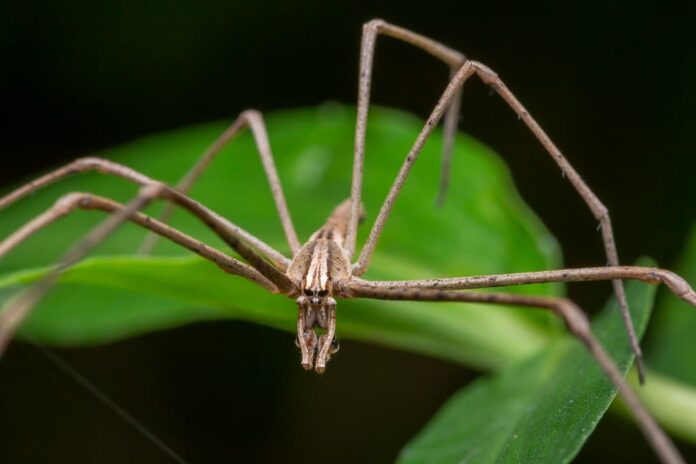You know how many animals in Australia can end your life in a blink of an eye, but there’s more. We are going to take a different turn and explore some weird-looking animals in Australia this time. When I say weird-looking, I want to talk about the animals that look so peculiar we question their existence. Could be bizarre, could be cute, and the judgment is all yours to make. Let’s take a look and see what you think.
1Badge Huntsman Spider
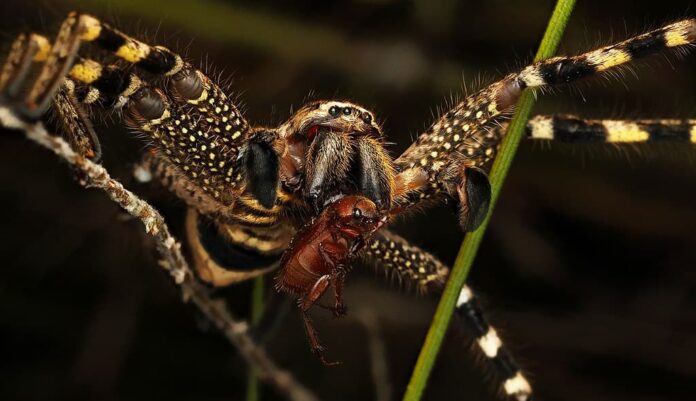
Huntsman is probably one of the most well-known spider species in Australia, and badge is one of them. A badge huntsman spider is large and long-legged, with a fawn or gray top. Usually, they have black, orange, yellow, or orange badge under their abdomen; hence, the first name badge. While being so large, these spiders have flattened bodies that allow them to adapt to living in narrow spaces. Along with that, their legs are equipped with twisted joints that allow them to be extra flexible.
Speaking of habitats, these spiders usually live under loose bark or rock crevices. Some also live on the ground and foliage while the ones in woodlands are burrow builders (either with or without trapdoors). No matter where they live, their diet only consists of insects and other invertebrates. And if you wonder whether they enter houses, the answer is yes but not as occasional as other huntsman species. Sometimes they also enter cars, usually found chilling behind sun visors or running across the dashboard.
Are they dangerous? Well, they do bite and the results of the bites are local severe pain, nausea, sweating, sweating, and vomiting. You can relieve the pain with a cold pack but make sure to seek medical attention if the symptoms persist.
2Bilby
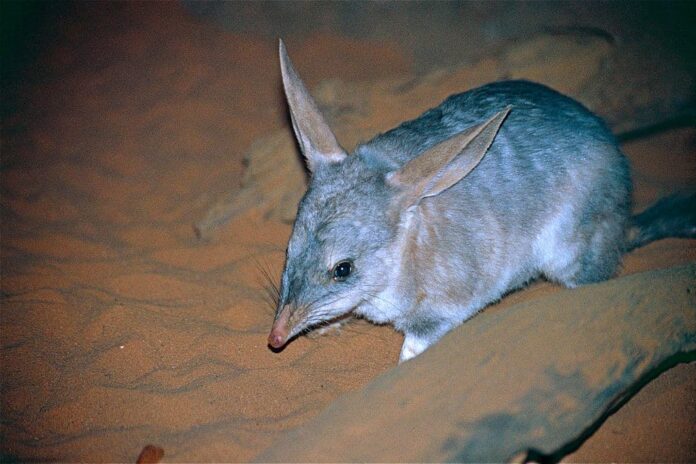
So a bilby is a rabbit-sized marsupial that has quite a strange appearance as you can see. The term “bilby” is an Aboriginal word used by the Yuwaalaraay people, meaning “long-nosed rat”. A bilby has a pointed head that tapers into a narrow snout, and its most noticeable feature is its big prominent ears. Bilbies have small black eyes, and their eyesight is not very good so they rely more on their sense of smell. This good sense of smell also helps them to detect danger as well because these nocturnal marsupials are active at night. They are omnivores, and they feed on both animals and plants including bulbs, fruits, seeds, lizards, small mammals, spiders, termites, and worms.
As a marsupial, does a bilby jump like a kangaroo? Absolutely not, a marsupial refers to the fact that the females have pouches in which they carry their young. The unique thing about their pouches is that they have a reverse pouch that opens at the bottom instead. This is to prevent dirt from entering the pouch when the bilby is burrowing. These little marsupials live in arid desert regions of Australia, where they use their strong claws and legs for digging. Bilbies are solitary, and they only come together for mating purposes.
Before, there used to be greater bilby and lesser bilby; however, the lesser bilby became extinct in the 1950s. As for the remaining bilby species nowadays, it is also considered Vulnerable as well. Their natural predators are eagles, lizards, and snakes but their main threats are introduced species such as feral cats and foxes. For modern threats, loss of habitat resulting from farming and mining is a major concern.
3Giant Fishkiller
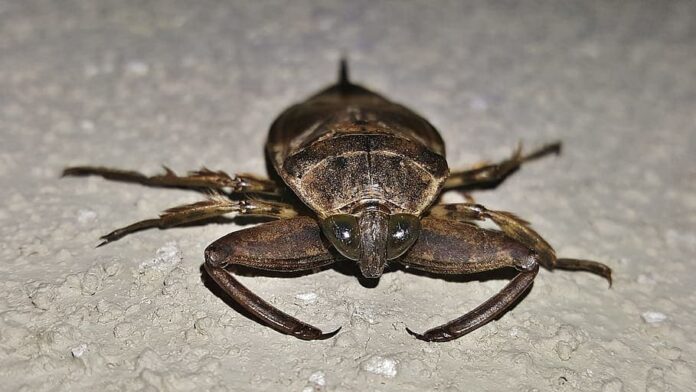
I mean, this is just a giant water but the nickname makes it more fearsome than it should be. Being the largest true bug in the world, a giant water bug can grow up to 5 inches in length. By the appearance, you can already see that these bugs have strong front legs. These legs help them to grab a hold of prey when they hunt. At the same time, they also have a very strong bite as well. And these bugs are known to occasionally bite humans when disturbed which inflicts great pain; hence the nickname “toe biter”.
Giant water bugs live in still freshwater bodies such as lakes and the Indo-Pacific ocean where they can hunt. The interesting thing is that these bugs hunt underwater, and the prey includes tadpoles, water insects, and small fish. Thanks to the posterior siphon they have, it functions like a snorkel that allows the bug to breathe under the water. The thing is that they feed on anything their large claws can get on. Their menu also includes their own young if they are very hungry or the young of other individuals.
Another interesting thing is that these water bugs can also fly, and they do so in their hunting sites. Not different from many bugs out there, giant water bugs are attracted to light as well. So it is also common for them to fly into cars at night.
4Goliath Stick Insect
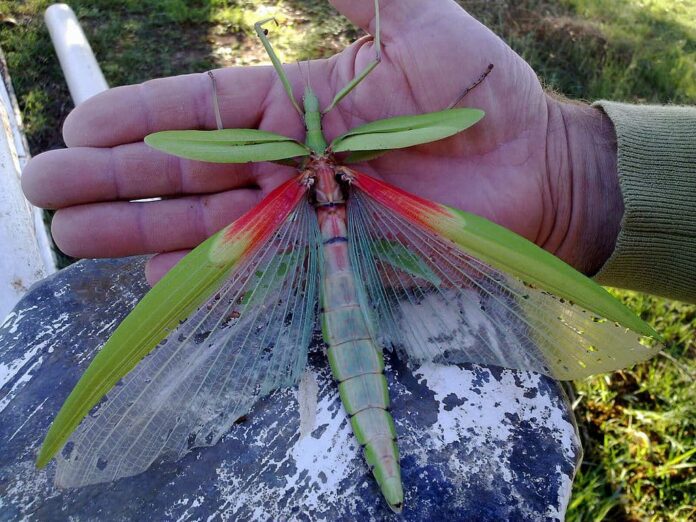
Apart from the largest bugs, you will also find the largest stick insects in Australia as well. What a fascinating country and continent! This giant stick insect species can grow up to 8 or even 10 inches in length, looking quite intimating. These insects have apple-green coloration on the body with yellow banding across the upper body. Their wings are also green, and the wings have red markings underneath. Female Goliath stick insects cannot fly, but their wings can act like parachutes if they fall out of a tree. Despite their size, these insects are harmless to humans though they sometimes land on a person’s back.
Goliath stick insects are widespread throughout Australia’s east coast in New South Wales and southern Queensland. Their common habitats are bushland, rainforests, and woodlands as well as green spaces like gardens and parks. They like to inhabit eucalyptus and broad-leafed Acacia tree species as these trees are their primary food plants. Goliath giant sticks feed at night and they hide during the day. Habitat loss is one of the main threats to their population, and frequent bushfires also affect their population greatly as well.
5Marsupial Mole
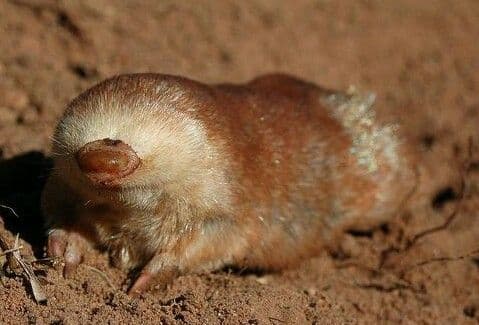
Marsupial moles have a cone-shaped head with a leathery shield over the muzzle. They have tubular body with a short tail. Marsupial moles are functionally blind, and they have no external ears at all. If you take a look at their limbs, you can see that they are very short. The forefeet have two enlarged spade-shaped flat claws that allow them to excavate soil in front of them. As for the hind feet, they are also flattened but with small claws that they use to push soil behind during digging.
When it comes to moles, everything is better underground. Marsupial moles spend most of their time underground, and they rarely come to the surface; the only marsupials that spend their entire lives underground. These moles usually come to the land of the above after rains. The most interesting thing about them is that they just swim through the soil, and they don’t leave behind any permanent burrows at all.
6Net-Casting Spider
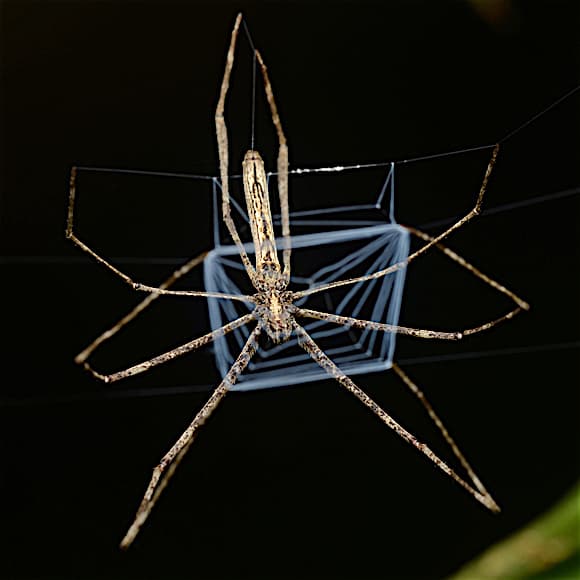
By the look, you can already that it is one of the weird-looking animals in Australia. A net-casting spider has a stick-like body and spindly legs along with a large pair of prominent eyes. These eyes earn them another nickname “Ogre-faced spiders”. The color of these spiders varies from fawn to pinkish brown or chocolate brown. Net-casting spiders are widely distributed in forest habitats but also common in garden shrubs and trees, especially on fine summer nights. And don’t you worry, these spiders are not dangerous to humans.
The name says it all, a net-casting spider is a type of spider that create elastic silk traps between its front four legs. This hunter uses the trap to net their prey, usually at night. When the time comes, a net-casting spider creates its net, and positions itself above an area where prey is likely to pass. A net-casting spider has two enormous eyes that allow them to see prey really well in low light; hence, effective night hunting. Once it spots its prey, it rapidly lunges forward as it expands the elastic net-like how humans net cast fish. Their primary meals are ants, beetles, crickets, and other spiders.
7Numbat
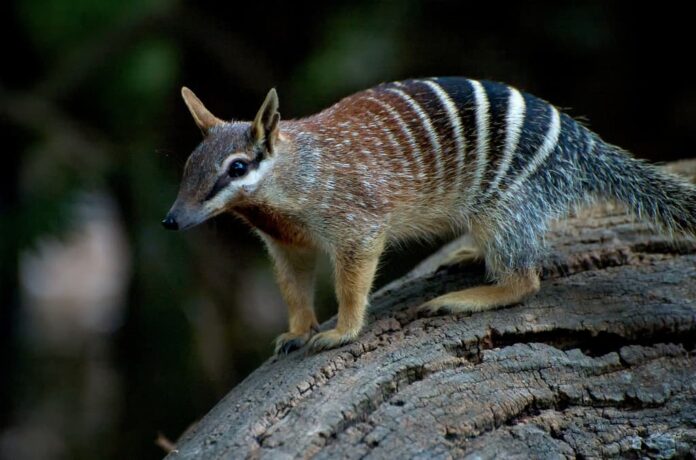
Also goes by the name Banded Anteater, numbat is a small marsupial native to parts of Australia. While the appearance is not so weird-looking, it still looks different from many other animals that we are familiar with. This marsupial has a slender body with 4 short legs and long claws. If you look closely, you can see the small upright ears on their pointed head. Numbats don’t have proper teeth, they have blunt pegs because they don’t chew their food. The color of this animal is grey-brown to reddish with black and white banding on the back and rump. A numbat has a long sticky tongue that allows them to pick up its most common food, termites.
What is so interesting about them is the senses that allow them to detect termites via smell and small vibrations in the ground. These marsupials live in eucalypt woodlands where old and fallen trees are common. They use those hollow logs as shelters, nest sites, and foraging. Numbats are endangered at the moment, and their main threats are habitat loss and introduced predators such as feral cats and foxes. There are only fewer than 1000 individuals, and hopefully, their population will be better in the near future.
8Pellucid Hawk Moth
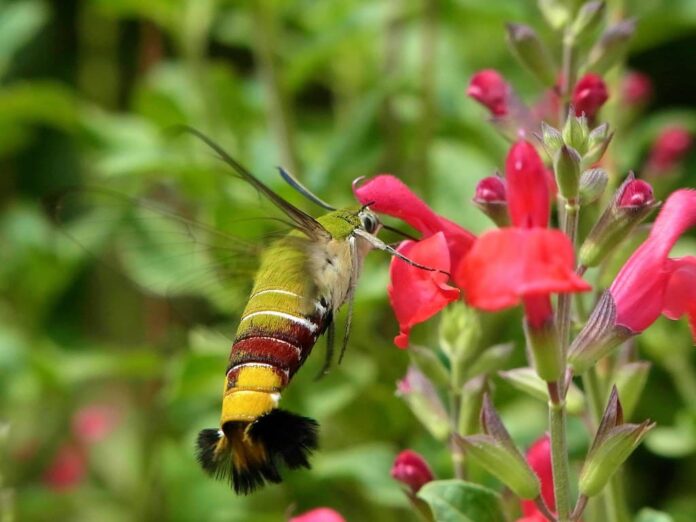
One of the most fascinating features of these weird-looking animals of Australia here is their transparent wings. The wings of these caterpillars are in triangular shape, and it is very thin. These flappy materials can reach up to 3 inches, and they also reflect most light which creates anti-reflection as well. So what are the benefits of this reflection? This distinctive feature makes it difficult for predators to see them, enhancing their survival rate.
While the wings are transparent with black edging and thin black veins, their bodies are rather bright. Pellucid hawk moths have bright green bodies with light gray faces and legs. Along with that, their head and spiracles are dark blue. As you can see, they also have broad bands of yellow and red with a dark edging across their bodies.
Apart from Australia, you can also find them in other parts of the world including Africa, India, Japan, Madagascar, Seychelles, and Southeast Asia. As long as the temperatures are warm enough and there are the right types of vegetation for them, those places can be their habitats. Not different from many other animal species around the world these days, these moths also face potential threats. Habitat loss is their greatest threat while climate change puts them in an even more difficult place.
9Spotted Quoll
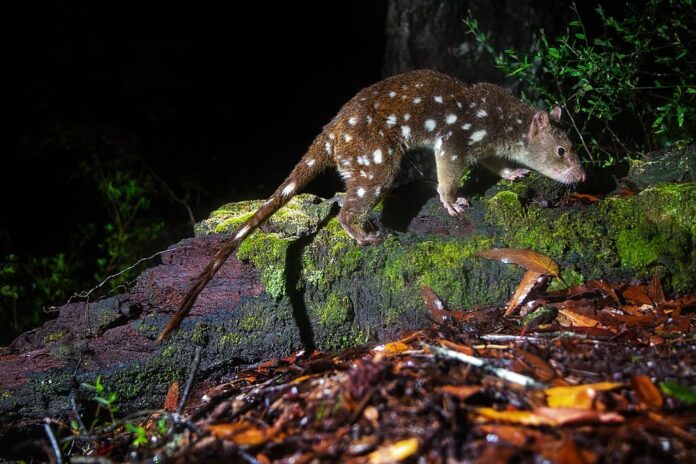
Spotted quoll aka tiger cat, is actually a carnivorous marsupial that is native to Australia. In fact, it is the world’s second-largest extant carnivorous marsupial; after the Tasmanian devil, of course. At the same time, they also have the second most powerful bite among carnivorous mammals today. Spotted quolls have short legs while their tails are as long as their body and head combined. The foot pads of these marsupials have ridges, allowing them to climb and adapt to their arboreal lifestyle. A spotted quoll has a reddish-brown pelage with white spots on its body and tail, and the colorations don’t change seasonally.
When it comes to habitats, tiger quolls live in a wide range of areas. However, their most favorite zones to live are in wet forests like closed eucalypt forests and rainforests. They have the ability to climb high into trees and make nocturnal hunts. So what do these carnivorous marsupials eat? Their common prey includes arboreal possums, birds crayfish, domestic poultry, insects, lizards, pademelons, platypus, rabbits, small mammals, small wallabies, and wombats. Even more surprisingly, tiger quolls also scavenge large prey like cattle, dingoes, feral pigs, and kangaroos. When attacking, a tiger quoll executes a killing bite to the base of the prey’s skill or the top of its neck.
The distribution and population of spotted quolls have dramatically declined, making them a vulnerable species in New South Wales. Their main threats are habitat loss due to degradation and fragmentation, human persecution, and predators such as feral cats, foxes, and more.
10Striped Anemone
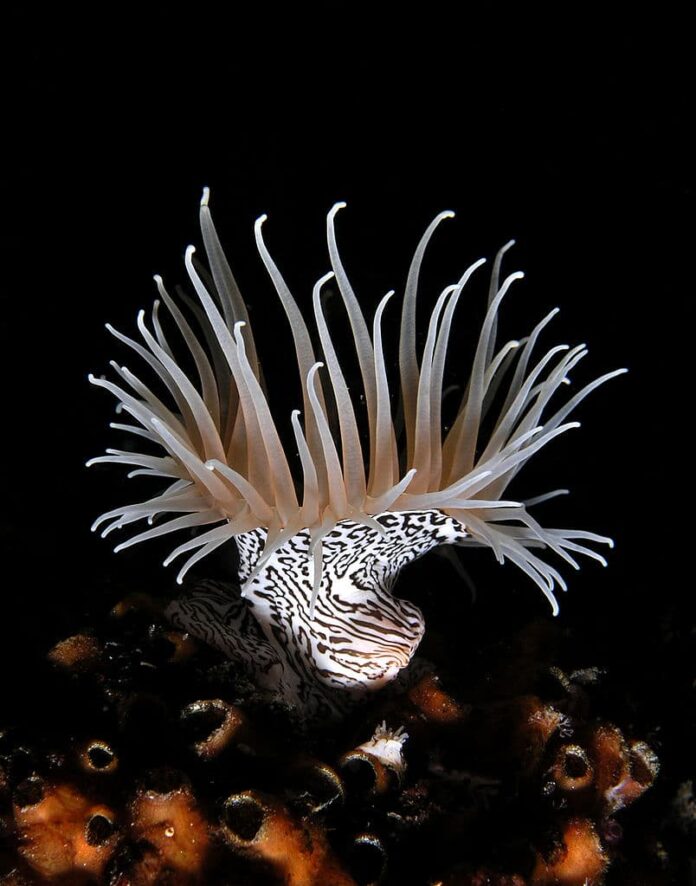
Striped anemones are no strangers to Australia’s waters, and they are one of the country’s weird-looking animals. Being one of the largest anemone in Australia, striped anemones can grow up to 20 centimeters big. Usually, a stripe anemone has a broad base with a smooth column that has a broad and flat oral disc. Meanwhile, their tentacles can be as long as 50 centimeters long. The interesting part is the fact that the long inner tentacles are almost double the length of the outer tentacles. These tentacles vary in colors such as brown, cream, or plain, and they striped; hence the name.
This anemone species live in the tropical waters of Australia but also in Indonesia and the Philippines. They live at depths of up to 20 meters, usually in mangroves, on sloping and sheltered reefs, or under rocky ledges. How do these sea creatures feed? They feed by catching small animals in the water with their tentacles. Even more impressive, they can also shoot out stinging cells from the holes in the sides of their column in defense. And that is one of the most important things that you have to know because they can be dangerous to humans. Simple contact with them can cause painful injuries that can take several months to heal.
Related Post: Weird-Looking Monkeys

